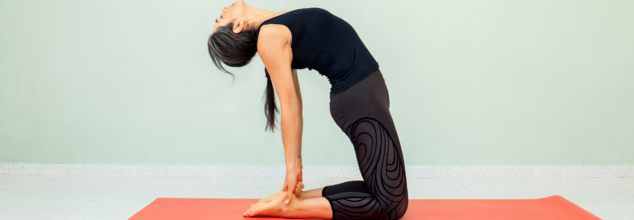- Health Conditions A-Z
- Health & Wellness
- Nutrition
- Fitness
- Health News
- Ayurveda
- Videos
- Medicine A-Z
- Parenting
- Web Stories
How To Adjust Your Fitness Routine As Per Your Menstrual Cycle?

Credits: Canva
Every woman’s body goes through different hormonal shifts throughout her menstrual cycle, which impacts energy levels, mood, and physical abilities. Knowing how to tailor your workout routine to each phase of your cycle can help you stay in sync with your body, boost energy, and prevent burnout.
Let's break down how you can adjust your fitness regime to align with the different stages of your menstrual cycle.
Understanding the Phases of Your Menstrual Cycle
The menstrual cycle consists of four distinct phases:
- Menstrual Phase (Day 1-5)
- Follicular Phase (Day 6-14)
- Ovulation Phase (Day 15-17)
- Luteal Phase (Day 18-28)
Each of these phases affects your hormones, energy levels, and exercise capacity in different ways.
Menstrual Phase (Day 1-5): Take It Slow
During the menstrual phase, hormone levels like estrogen and progesterone are at their lowest, leaving you feeling low in energy. This is the time when your body is shedding the uterine lining, and you might experience cramps, fatigue, and mood swings.
Best workout approach:
It’s crucial to listen to your body and prioritize restorative practices. Opt for gentle, low-impact exercises like walking, light yoga, or stretching. This is also an excellent time to focus on self-care practices and give yourself permission to rest. Your body will thank you for it, especially if you’re feeling fatigued. If you do exercise, focus on breathing and relaxation rather than intensity.
Follicular Phase (Day 6-14): Boost Your Strength
The follicular phase begins right after your period ends. During this time, estrogen levels start rising, giving you a surge in energy, strength, and mood. Your body becomes more resilient, and you may feel motivated to take on more challenging activities.
Best workout approach:
This is the best time to engage in strength training and high-impact cardio. Your body can handle the stress of more intense exercises like weightlifting, running, or cycling. Because your energy levels are increasing, you can push yourself harder during workouts. It's also a great time to tackle projects or focus on goals, both physically and mentally.
Ovulation Phase (Day 15-17): Maximize Your Power
Around ovulation, estrogen peaks, and you might feel your strongest and most vibrant self. This is often referred to as the phase of high energy and vitality, which can also make you feel more social.
Best workout approach:
This is the perfect time for endurance and stamina training. Whether it’s a long run, an intense HIIT session, or even a competitive game, your body is primed for high performance. Social activities like group fitness classes or outdoor adventures with friends will also feel enjoyable and energizing.
Luteal Phase (Day 18-28): Wind Down Gradually
In the luteal phase, hormones fluctuate, and energy levels gradually start to dip as the body prepares for menstruation. You may feel more irritable or sluggish, especially as you approach the final days of this phase.
Best workout approach:
Focus on gentle, low-impact exercises like yoga, Pilates, or stretching. It’s also a good idea to incorporate stress-reducing activities like meditation or breathing exercises to help balance mood swings. Eating foods rich in magnesium and B-vitamins can help boost your energy and soothe premenstrual symptoms. This is also a time to practice relaxation techniques and give yourself room to rest when needed.
Why Curate Your Workouts According to Your Cycle?
Adjusting your fitness routine based on your menstrual cycle allows you to honor your body’s natural rhythm. By doing so, you can optimise your performance, prevent over-exertion, and feel more in tune with your body’s needs. Tailoring your exercise according to each phase ensures that you’re working with your body, not against it, leading to more consistent progress, fewer injuries, and a healthier relationship with fitness.
Disclaimer: Before making any changes to your workout routine, it is advisable to contact your trainer and your doctor.
Can Yoga Help Your Thyroid Issues?

Yoga is a great exercise known for reducing stress and improving overall well-being. But can it also help with thyroid problems? The thyroid is a small gland in your throat that makes hormones vital for your metabolism, body temperature, growth, and even brain development in children. When your thyroid isn't working right, it can affect both your physical and mental health. This article explores how yoga can be a helpful addition to traditional thyroid treatments.
Poses You Can Do
While yoga generally promotes overall health, some poses specifically target the neck and throat area, where the thyroid is located. Stretching and strengthening this region might improve blood flow, though there's no definite proof that these specific poses benefit the thyroid more than others.
It's important to only hold poses as long as you feel comfortable. Many of the poses described below are for those with some yoga experience. You can make them easier with props or by practicing under the guidance of a certified yoga instructor. You can try each of these poses at home with a yoga mat.
Supported Shoulder Stand (Sarvangasana)
This advanced pose puts you upside down. Avoid it if you are new to yoga, have high blood pressure, heart issues, glaucoma, or are pregnant. Lie on your back, lift your legs straight up, and push onto your shoulders, supporting your hips with your hands. Keep your body straight and core strong.
Plow Pose (Halasana)
This advanced pose builds core and arm strength, plus spine flexibility. Start like the shoulder stand. Bring your legs over your head to rest your toes on the floor behind you, keeping your lower back supported. If breathing gets hard, slowly stop. A prop under shoulders can make it safer.
Fish Pose (Matsyasana)
This advanced pose stretches your body in the opposite direction after other poses. Don't do it if you have high blood pressure, neck injuries, or glaucoma. Sit, place hands under buttocks, lean back on elbows, and gently drop your head back, lifting your chest.
Bridge Pose (Setu Bandha Sarvangasana)
This pose is great for strengthening your back. Lie on your back, bring feet close to hips. Press palms into the floor and lift your hips toward the ceiling. You can use your hands on your lower back for support if needed.
Cobra Pose (Bhujangasana)
This pose helps make your back and neck more flexible. Lie on your stomach with palms under shoulders. Press into your palms and lift your head and chest off the mat, arching your back. Drop your head back if comfortable.
Boat Pose (Navasana)
Sit with legs out. Lean back slowly, keeping your core strong and back straight. Lift your bent knees, then straighten legs to form a V-shape. Raise arms in line with shoulders. Hold, breathing deeply. Slowly lower arms and legs.
Upward Bow Pose / Wheel Pose (Urdhva Dhanurasana)
This pose deeply stretches your chest, back, and neck. Lie on your back, bend knees, and place hands by your head. Press feet and hands, lifting hips and then your head until arms are straight. Hold and breathe.
Supported Headstand Pose (Sirshasana)
This is a very advanced pose for experienced yoga practitioners, always do it with a teacher at first. Kneel, interlace fingers, and place head on mat. Lift knees, walk feet closer, then slowly lift both feet up, balancing on forearms.
Biking Can Help Your Brain Stay Young - Study Finds Biking To Reduce Risk Of Dementia

(Credit-Canva)
Memory loss is an issue many people believe they will only have to face when they are older. However, diseases like dementia can happen to anyone, while it happens very rarely to people at a young age, the choices you make at these formative years have a great impact on your mind. Studies have shown how people who eat too much processed foods, do not engage in social activities and many other unhealthy habits, increase their chances of dementia and other cognitive degenerative diseases.
Just as some choices can increase the chances, there are also habits that can decrease the chances of you getting these diseases.
One of the best ways to decrease your chances of cognitive decline at an early age is by incorporating healthy habits into your life, like eating more plant-based and unprocessed foods, fixing your sleeping habits as well as exercising
A new study published in the JAMA Network Open suggests that regularly riding a bicycle could be a key factor. Research published recently indicates that using a bike for getting around might reduce the risk of dementia by 19% and Alzheimer's disease by 22%.
How Cycling Helps Your Brain
The study also hinted that cycling might even help increase the size of a brain area crucial for memory. Experts explain that cycling is a moderately intense workout that also requires balance. This need for more complex brain activity, compared to simply walking, might be why it's more effective in lowering dementia risk. It's not just about adding exercise to your routine; it's about making active travel part of your daily life. Choosing to bike instead of drive for short trips can significantly contribute to your well-being.
Large Study Shows the Link
To reach these conclusions, researchers analyzed health data from almost 480,000 people in a long-term health study in the UK. Participants shared how they most often traveled, excluding commutes to and from work. Over an average of 13 years, more than 8,800 participants developed dementia, and nearly 4,000 developed Alzheimer’s.
The findings showed a lower risk for both dementia and Alzheimer’s among those who cycled or who combined cycling with other forms of travel like walking, driving, or public transportation. The research team noted that promoting active travel, especially cycling, could significantly benefit public health by offering an accessible and sustainable way to maintain brain health in middle-aged and older adults.
Cycling's Impact on Brain Structure and Genetics
Brain scans (MRIs) further supported the findings, showing that cycling was linked to a larger hippocampus, which is a part of the brain important for forming memories and learning.
However, the benefits of cycling seemed to be strongest for people without a specific genetic risk factor for Alzheimer's (the APOE E4 genetic variant). For these individuals, cycling was associated with a 26% lower risk of dementia and a 25% lower risk of Alzheimer's. The protective effect of cycling was less clear for those with the APOE E4 gene.
Interestingly, the study also hinted that driving a car offered some protection against dementia when compared to using public transportation like buses or subways. This suggests that even less active forms of travel might have some brain health benefits over passive modes.
Important Considerations and Future Advice
It's important to remember that this study observed a connection, but it doesn't directly prove that cycling causes healthy brain aging. Still, the message is clear: anything that gets you outdoors and active is beneficial for your brain. It's not just the physical movement, but also the balance and the way it engages different parts of your brain. If you're able to ride a bike, it's recommended. If not, walking is still highly encouraged. The key takeaway is to choose an active way to move your body whenever possible.
Strong Ankles, Less Injuries: Yoga Poses That Can Help Strengthen Your Ankle

(Credit-Canva)
Do you often worry about twisting your ankle? Are you experiencing foot pain, balance issues, or decreased mobility as you get older? These could all be signs that your ankles are weak. While you may not notice it as much, ankles are a big part of our balance and strength foundation. They support our movements, whether it is walking, running, stretching, or even simple flexing.
When our ankles grow weak, things and situations start changing, however you may not realize it may be due to your weak ankles. You may be getting into situations like twisting your ankles more often, experiencing pain during normal movements, etc. The Cleveland Clinic explains that weak ankles have a great effect on your knees and hips. They explained that deficient ankles cause more strain on your knees as well as the internal rotation of your hips, ultimately making it difficult to walk. However, it can be improved.
Yoga Poses for Strong Ankles
The good news is that you can actively work to strengthen these crucial ankle muscles and the connective tissues around them. This effort will not only help prevent injuries but also significantly improve your balance and overall movement. Here are some yoga poses you can do to improve your ankle health.
Camel Pose (Ustrasana)
This pose involves kneeling and arching your back, reaching for your heels. It strengthens the front of the ankles and feet while also improving overall stability and flexibility in the lower body. As you press your shins and tops of your feet into the ground, your ankles engage to support the pose.
Chair Pose (Utkatasana)
Imagine sitting in an invisible chair. This pose deeply engages the muscles in your calves and ankles as you lower your hips. It builds strength in the entire foot and ankle complex, improving stability and endurance, which are crucial for preventing ankle rolling during daily activities or sports.
Child's Pose (Balasana)
While primarily a resting pose, Child's Pose can gently stretch the top of your feet and ankles, especially if you sit back on your heels. It helps to release tension and improve flexibility in the ankle joint, which is important for overall ankle health and reducing stiffness.
Cow Face Pose (Gomukhasana)
This seated pose involves stacking your knees. While the main focus is on the hips, the feet and ankles are gently stretched and aligned. It encourages external rotation in the ankles and can help release tension, improving overall ankle mobility and preventing common stiffness that can lead to injury.
Eagle Pose (Garudasana)
Standing on one leg while wrapping the other around it, Eagle Pose is a powerful balance pose that significantly challenges and strengthens the stabilizing muscles around your standing ankle. It builds incredible ankle stability, proprioception (your body's awareness in space), and improves overall balance, making your ankles more resilient against twists and sprains.
Easy Pose (Sukhasana)
A simple cross-legged seated pose, Easy Pose might seem basic, but it's foundational for ankle flexibility. It gently stretches the ankles and feet, improving comfort in seated positions and maintaining mobility in the joint. This consistent gentle stretching helps prevent stiffness that can contribute to weak ankles.
Eight-Angle Pose (Astavakrasana)
This advanced arm balance requires significant core and arm strength, but it also heavily relies on strong and flexible ankles to hook around the arm and support the body's weight. It dramatically builds strength and control in the entire ankle joint, demanding high levels of stability and engagement.
Extended Hand-to-Big-Toe Pose (Utthita Hasta Padangusthasana)
This standing balance pose involves extending one leg forward or to the side. It greatly challenges the stabilizing muscles of your standing ankle. Holding this pose strengthens the ankle's ability to maintain balance and withstand shifts in weight, crucial for preventing common ankle injuries during movement.
© 2024 Bennett, Coleman & Company Limited

